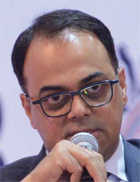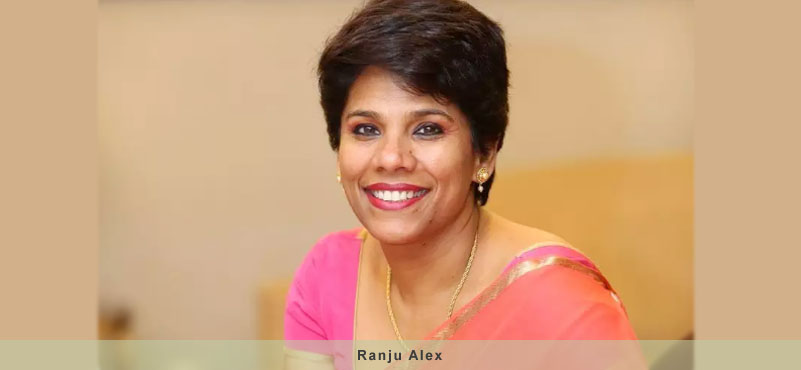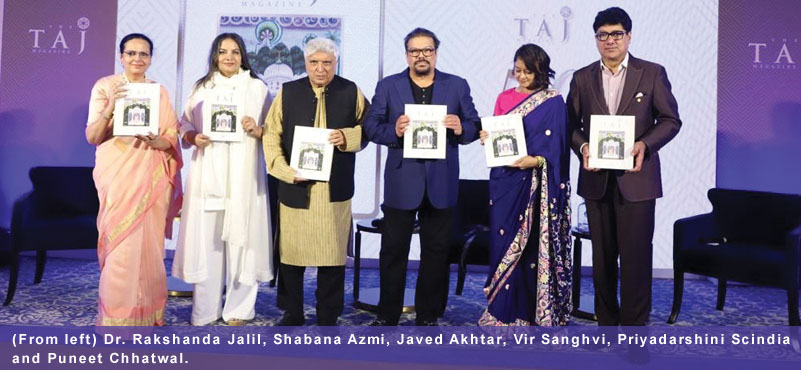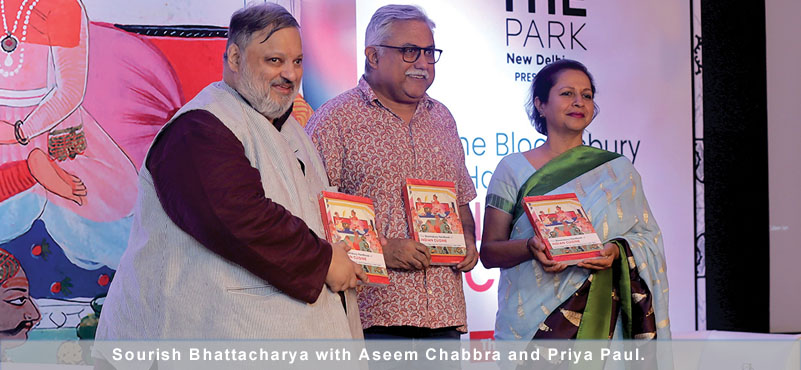Having recently concluded the much anticipated acquisition of the Starwood group, the time now was to iron out the intricacies of the merger, creating an organizational structure and taking a concerted step forward, said Rajeev Menon, CEO, Asia Pacific, Marriott Group. In a candid one-on-one interaction with Manav Thadani, he reminisced about his early days, shed light on the challenges moving forward and a lot more. Excerpts:
 MT: How do you travel so much, Raj?
MT: How do you travel so much, Raj?
RM: It is a vitamin pill that I am not giving you the recipe for.
MT: I will start with a very simple question. What inspired you to get into the hospitality business?
RM: As many of my colleagues know, my first dream was to become an Airforce pilot. I actually got rejected from the Airforce because of my eyes, and ended up in the hotel business. This was my second big passion…did have some family members who worked in hotels – and I was just enamoured by the glamour of the hotel business. Did realise that the reality is different on my first day as an apprentice when I walked in, and had to clean 24 racks of glasses over the night shift. I almost gave up the hotel business. But I survived that day, and surviving still, and loving every minute of what I do.
MT: Have you ever worked outside of the Marriott?
RM: I have. I started my career with ITC as a management trainee…worked there for a few years before I actually left for Australia. There I worked for Radisson and another hotel brand before I worked for the Marriott, almost 16 years ago, now.
MT: Wow! Life comes to a full circle. You would be working with Dipak again, since you now have some of their hotels?
RM: It was such a treat. We caught up only a few weeks ago. And, yeah we talked about the old times, but more importantly about the future and all the things that we can do together.
MT: Right. I asked this question to Kapil, too. Tell me one time when you failed as a young employee.
RM: I did. I am through and through a F&B guy. And when I was thrown at the front desk and also at housekeeping, particularly housekeeping, I genuinely failed. But thanks to some real tough environment back in the Sea Rock days, when there was a strike situation. There were a hundred of us, who ran the hotel for four months. With about 55% occupancy, we had to work on an average about 18 hours a day. I had to learn everything all over again. And honestly, I stand on every pedestal and say that those 4 months were the single best learning experience of my career.
MT: Why do you think Indian hotels have been finding difficult to push average rates up?
RM: I think, broadly, as hoteliers, and in many cases developers, have had issues with regards to developing assets and the cost base. I have talked about this before. There are a bunch of reasons for this. One is that when you look at the hotel economic model in India, to me, when a developer gets a 10-year loan – which now is kind of improving a little bit – but it takes 4-5 years to build the hotel. And then you have a considerable supply sitting in front of you. When you open a hotel, there is almost a panic situation to get cash flows in. And that panic creates a real issue in my world, when the first thing to do is to drop rates to drive occupancy to drive cash flows to the business – and that then starts a series of events that does not help from a broader macro market point of view. So, the reality is that in India there has been a bit of a supply-demand mismatch in certain micro markets. As we look forward, we generally believe that there is immense opportunity to move rates. You know, you look at this year. There has been about 6.5% RevPar growth in the industry. In our business, we have released our second quarter results and just at Marriott, we are growing at double-digit this year, yet again – as we did last year, in terms of RevPar. So, I think as we move forward, there will be considerable opportunity to move rate.
MT: Well, obviously, you have been asked this question. But, first congratulations on the Marriott-Starwood deal. What is your vision for the two entities in India and how do you see that rolling out?
RM: Thanks. You know, Independently and together, with Marriott and now Starwood, we have always believed that India is a decades-long growth story. You see the great work that Starwood has done over the years in positioning their brand, in partnership they have with ITC. And you look at our portfolio of Marriott hotels and how we have grown. We are uniquely positioned today. We see immense possibilities as we move forward. To me, India in the next 10-20 years will see tremendous growth in almost every lodging segment there is. And we want to have brands that are positioned in these lodging segments. Today, we operate 14 brands. We are about to bring W into Goa, which is a stunning brand, and is going to be a stunning hotel. I have been there a couple of weeks ago. We see great opportunities for hotel brands like Moxy and AC, and a couple of other Starwood brands that would come into this market. So, India is ripe for growth; we are seeing the cycle turn. And as I have said for years, this is a decades-long growth story and will continue.
MT: I think the hotel industry has never seen two such large entities come together. How difficult and challenging has that process been?
RM: We have only closed the deal two weeks ago, now. And we have a lot of work ahead of us. We have started the integration process. In the next few weeks, we will announce the organisation structure – and our focus has clearly been to bring the best of Starwood talent and the Marriott talent, together to create what will be, what is the largest hotel company. It will establish itself as the largest hotel company in India. What is more important for me is that it would have the best brands in every lodging segment in its class.
MT: Does that also mean that since you are the big elephant in the room, your flexibility will be a little compromised and that you will move a little slower in decision making?
RM: Well, we all go through our learnings. I will be a fool to say that everything is going to be perfect. I think, we are going to stumble. But I can assure you of a couple of things. One, there has been immense amount of planning that has going into this in the last number of months. We announced the deal ten months ago. And many folks here would know, we had a Chinese company in there which kind of slowed the process down. I remember working on planning since December last year. So one, there has been a lot of planning.
Two, as a company, we have a history of acquiring hotel companies. So if you look at the last year, we acquired Delta – which is one of the biggest operators in Canada. Couple of years ago acquired Protea, which is one of the biggest players in Africa. Before that we had AC by Marriott. We have done Ritz-Carlton in the late 90’s; we have done Renaissance. So Marriott has a history of acquiring hotel companies. It is just that this time it is the single biggest acquisition in the industry. And I think, it is going to take time for us to bring the two companies together, integrate them effectively and learn from some of the mistakes that we will make. But our clear focus is to really be nimble, humble, learn from each other and the market and make corrections as we move forward. I think I feel reasonably positively in where we are today after two weeks.
MT: How do you make the owners of different hotels come together? Some of them may turn around and say that there are just too many eggs in the same basket.
RM: When we started operating in India in Mumbai, and when we launched our second hotel, there was a question that Marriott has got two hotels in the same market. Today, we have four hotels in that market, just the Marriott alone. Two more with Starwood, and when you look at the Marriott portfolio, it is extremely successful. I will take you to other cities like Shanghai, where Marriott alone has 22 operating hotels. With Starwood it turns to 40 properties. And what we have seen that the more hotels we open in a particular city, we have the ability, and more often than not, we improve our market share of those hotels. Simply because as the distribution grows, we have the ability to sit in front of the customer and give him options. And, we have been doing this for many many years. So, I think it is about clearly defining. Starwood has an incredible portfolio. You look at Westin, W, St. Regis, Sheraton – which is where I started my career. There is a lot of runway for each of these brands, including all the Marriott brands. And the reason I say we is that as of two weeks ago, there is no Starwood. There is one company and that is Marriott International.
MT: What is your view on aggregators and disruptors? Should they be viewed as competition, or do you think that we can wish them away? What is your thoughts on that?
RM: My view has been that over the years India has had two distinct lodging segments. One is the 4-star, 5-star and 5-star+ in the luxury space and the rest has been fragmented – guest houses, yatri niwas and all those kinds of accommodation. What is happening now is that a lot of these aggregators are in that fragmented space trying to aggregate. At least for the next decade, I see no real competition from our perspective. It will all depend on how they come together and develop successful business models, but as we look at our brand portfolio today, starting from Fairfield, Courtyard by Marriott, Four Points by Sheraton and upwards, we do not see any competition at all.




































